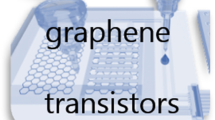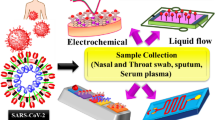Abstract
The idea is to develop nanostructure based biosensing platforms as commercial diagnostic tools for early stage non-invasive virus detection to enhance the selectivity from the existing electrical biosensors by introducing additional electrical signatures and correlating electrical characterization data with other proteomics characterization results. The aim of this proposed research is the performance enhancement of available nanobiosensors in terms of sensitivity and selectivity for the early and rapid diagnosis and prognosis of viral infections.






















Similar content being viewed by others
References
Li J, Pud S, Petrychuk M et al (2014) Sensitivity enhancement of Si nanowire field effect transistor biosensors using single trap phenomena. Nano Lett 14:3504–3509. https://doi.org/10.1021/nl5010724
Aroonyadet N, Wang X, Song Y et al (2015) Highly scalable, uniform, and sensitive biosensors based on top-down indium oxide nanoribbons and electronic enzyme-linked immunosorbent assay. Nano Lett 15:1943–1951. https://doi.org/10.1021/nl5047889
Ghosh H, Roychaudhuri C (2013) Ultrasensitive food toxin biosensor using frequency based signals of silicon oxide nanoporous structure. Appl Phys Lett 102:243701. https://doi.org/10.1063/1.4811409
Martinez-Cisneros CS, Sanchez S, Xi W, Schmidt OG (2014) Ultracompact three-dimensional tubular conductivity microsensors for ionic and biosensing applications. Nano Lett 14:2219–2224. https://doi.org/10.1021/nl500795k
Han J-H, Lee D, Chew CHC et al (2016) A multi-virus detectable microfluidic electrochemical immunosensor for simultaneous detection of H1N1, H5N1, and H7N9 virus using ZnO nanorods for sensitivity enhancement. Sens Actuators B Chem 228:36–42. https://doi.org/10.1016/j.snb.2015.07.068
Guo S, Wen D, Zhai Y et al (2010) Platinum nanoparticle ensemble-on-graphene hybrid nanosheet: one-pot, rapid synthesis, and used as new electrode material for electrochemical sensing. ACS Nano 4:3959–3968. https://doi.org/10.1021/nn100852h
Gupta V (2010) ZnO based third generation biosensor. Thin Solid Films 519:1141–1144. https://doi.org/10.1016/j.tsf.2010.08.058
Akhavan O, Ghaderi E, Rahighi R (2012) Toward Single-DNA Electrochemical Biosensing by Graphene Nanowalls. ACS Nano 6:2904–2916. https://doi.org/10.1021/nn300261t
Gao N, Gao T, Yang X et al (2016) Specific detection of biomolecules in physiological solutions using graphene transistor biosensors. Proc Natl Acad Sci 113:14633–14638. https://doi.org/10.1073/pnas.1625010114
Ahmad R, Ahn M-S, Hahn Y-B (2017) ZnO nanorods array based field-effect transistor biosensor for phosphate detection. J Colloid Interface Sci 498:292–297. https://doi.org/10.1016/j.jcis.2017.03.069
Ahmad R, Tripathy N, Ahn M-S et al (2017) Highly efficient non-enzymatic glucose sensor based on CuO modified vertically-grown ZnONanorods on electrode. Sci Rep. https://doi.org/10.1038/s41598-017-06064-8
Ahmad R, Tripathy N, Ahn M-S, Hahn Y-B (2017) Solution process synthesis of high aspect ratio ZnO nanorods on electrode surface for sensitive electrochemical detection of uric acid. Sci Rep. https://doi.org/10.1038/srep46475
Ahmad R, Tripathy N, Hahn Y-B (2013) High-performance cholesterol sensor based on the solution-gated field effect transistor fabricated with ZnO nanorods. Biosens Bioelectron 45:281–286. https://doi.org/10.1016/j.bios.2013.01.021
Ahmad R, Tripathy N, Jung D-U-J, Hahn Y-B (2014) Highly sensitive hydrazine chemical sensor based on ZnO nanorods field-effect transistor. Chem Commun 50:1890. https://doi.org/10.1039/c3cc48197b
Ahn M-S, Ahmad R, Bhat KS et al (2018) Fabrication of a solution-gated transistor based on valinomycin modified iron oxide nanoparticles decorated zinc oxide nanorods for potassium detection. J Colloid Interface Sci 518:277–283. https://doi.org/10.1016/j.jcis.2018.02.041
Fathollahzadeh M, Hosseini M, Norouzi M et al (2017) Immobilization of glucose oxidase on ZnO nanorods decorated electrolyte-gated field effect transistor for glucose detection. J Solid State Electrochem 22:61–67. https://doi.org/10.1007/s10008-017-3716-y
Kumar N, Senapati S, Kumar S et al (2016) Functionalized vertically aligned ZnO nanorods for application in electrolyte-insulator-semiconductor based pH sensors and label-free immuno-sensors. J Phys: Conf Ser 704:012013. https://doi.org/10.1088/1742-6596/704/1/012013
Ibupoto ZH, Ali SMU, Khun K et al (2011) ZnO nanorods based enzymatic biosensor for selective determination of penicillin. Biosensors 1:153–163. https://doi.org/10.3390/bios1040153
Yu X, Xia Y, Tang Y et al (2017) Pathogen detection: a nanostructured microfluidic immunoassay platform for highly sensitive infectious pathogen detection (Small 24/2017). Small. https://doi.org/10.1002/smll.201770131
Sasmal M, Maiti TK, Bhattacharyya TK (2015) Synthesis of ZnO nanosphere for picomolar level detection of bovine serum albumin. IEEE Trans Nanobiosci 14:129–137. https://doi.org/10.1109/tnb.2014.2359072
Sasmal M, Maiti TK, Bhattacharyya TK (2015) Ultra-low level detection of L-histidine using solution-processed ZnO nanorod on flexible substrate. IEEE Trans Nanobiosci 14:634–640. https://doi.org/10.1109/tnb.2015.2430753
Munje RD, Muthukumar S, Prasad S (2016) Interfacial tuning for detection of cortisol in sweat using ZnO thin films for wearable biosensing. 2016 IEEE Nanotechnology Materials and Devices Conference (NMDC). doi: 10.1109/nmdc.2016.7777154
Afsahi S, Lerner MB, Goldstein JM et al (2018) Novel graphene-based biosensor for early detection of Zika virus infection. Biosens Bioelectron 100:85–88. https://doi.org/10.1016/j.bios.2017.08.051
Yue W, Jiang S, Xu S, Bai C (2014) Fabrication of integrated field-effect transistors and detecting system based on CVD grown graphene. Sensors and Actuators B: Chemical 195:467–472. https://doi.org/10.1016/j.snb.2014.01.071
Yue HY, Huang S, Chang J et al (2014) ZnO nanowire arrays on 3D hierachical graphene foam: biomarker detection of Parkinson’s disease. ACS Nano 8:1639–1646. https://doi.org/10.1021/nn405961p
Tiwari S, Vinchurkar M, Rao VR, Garnier G (2017) Zinc oxide nanorods functionalized paper for protein preconcentration in biodiagnostics. Sci Rep. https://doi.org/10.1038/srep43905
Basu J, Roychaudhuri C (2017) Corrections to “Attomolar Sensitivity of FET Biosensor Based on Smooth and Reliable Graphene Nanogrids” [Apr 16 492–495]. IEEE Electron Device Lett 38:407–407. https://doi.org/10.1109/led.2017.2655545
Basu J, Datta S, Roychaudhuri C (2015) A graphene field effect capacitive Immunosensor for sub-femtomolar food toxin detection. Biosens Bioelectron 68:544–549. https://doi.org/10.1016/j.bios.2015.01.046
Basu J, Roychaudhuri C (2016) Graphene nanogrids FET immunosensor: signal to noise ratio enhancement. Sensors 16:1481. https://doi.org/10.3390/s16101481
Basu J, Roychaudhuri C (2018) Biomolecule detection in high ionic strength with enhanced sensitivity using graphene nanogrid FET immunosensor. Mater Today Proc 5:9881–9887. https://doi.org/10.1016/j.matpr.2017.10.182
Chakraborty B, Ghosh S, Das N, Roychaudhuri C (2018) Liquid gated ZnO nanorod FET sensor for ultrasensitive detection of Hepatitis B surface antigen with vertical electrode configuration. Biosens Bioelectron 122:58–67. https://doi.org/10.1016/j.bios.2018.09.019
Chakraborty B, Chakrabarty S, Ghosh S, Chaudhuri CR (2018) High performance biosensor based on RGO/ZnO thin film transistor. 2018 IEEE Sensors. doi: 10.1109/icsens.2018.8589592
Corso CD, Dickherber A, Hunt WD (2008) An investigation of antibody immobilization methods employing organosilanes on planar ZnO surfaces for biosensor applications. Biosens Bioelectron 24:805–811. https://doi.org/10.1016/j.bios.2008.07.011
Das RD, Maji S, Das S, Roychaudhuri C (2010) Optimization of covalent antibody immobilization on macroporous silicon solid supports. Appl Surf Sci 256:5867–5875. https://doi.org/10.1016/j.apsusc.2010.03.066
Park J-S, Cho MK, Lee EJ et al (2009) A highly sensitive and selective diagnostic assay based on virus nanoparticles. Nat Nanotechnol 4:259–264. https://doi.org/10.1038/nnano.2009.38
Acknowledgements
This research has been supported by Visvesvaraya Ph.D. Scheme and Visvesvaraya Young Faculty Research Award funded by the Ministry of Electronics & Information Technology, Government of India.
Author information
Authors and Affiliations
Corresponding author
Rights and permissions
About this article
Cite this article
RoyChaudhuri, C., Chakraborty, B. Development of low noise FET biosensor using graphene and ZnO nanostructures on cost effective substrates for biomolecule detection with enhanced performance. CSIT 8, 129–136 (2020). https://doi.org/10.1007/s40012-020-00308-1
Received:
Accepted:
Published:
Issue Date:
DOI: https://doi.org/10.1007/s40012-020-00308-1




